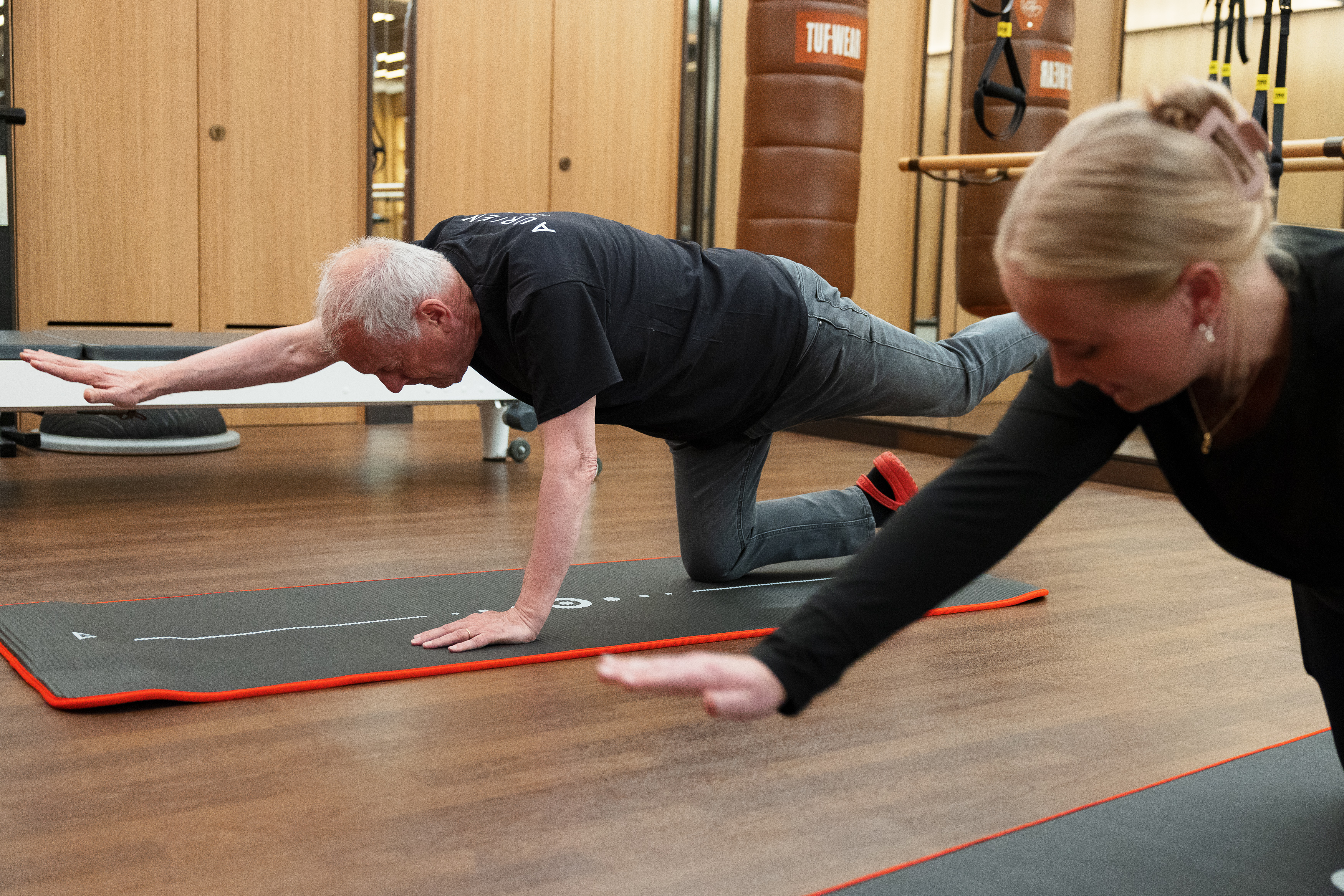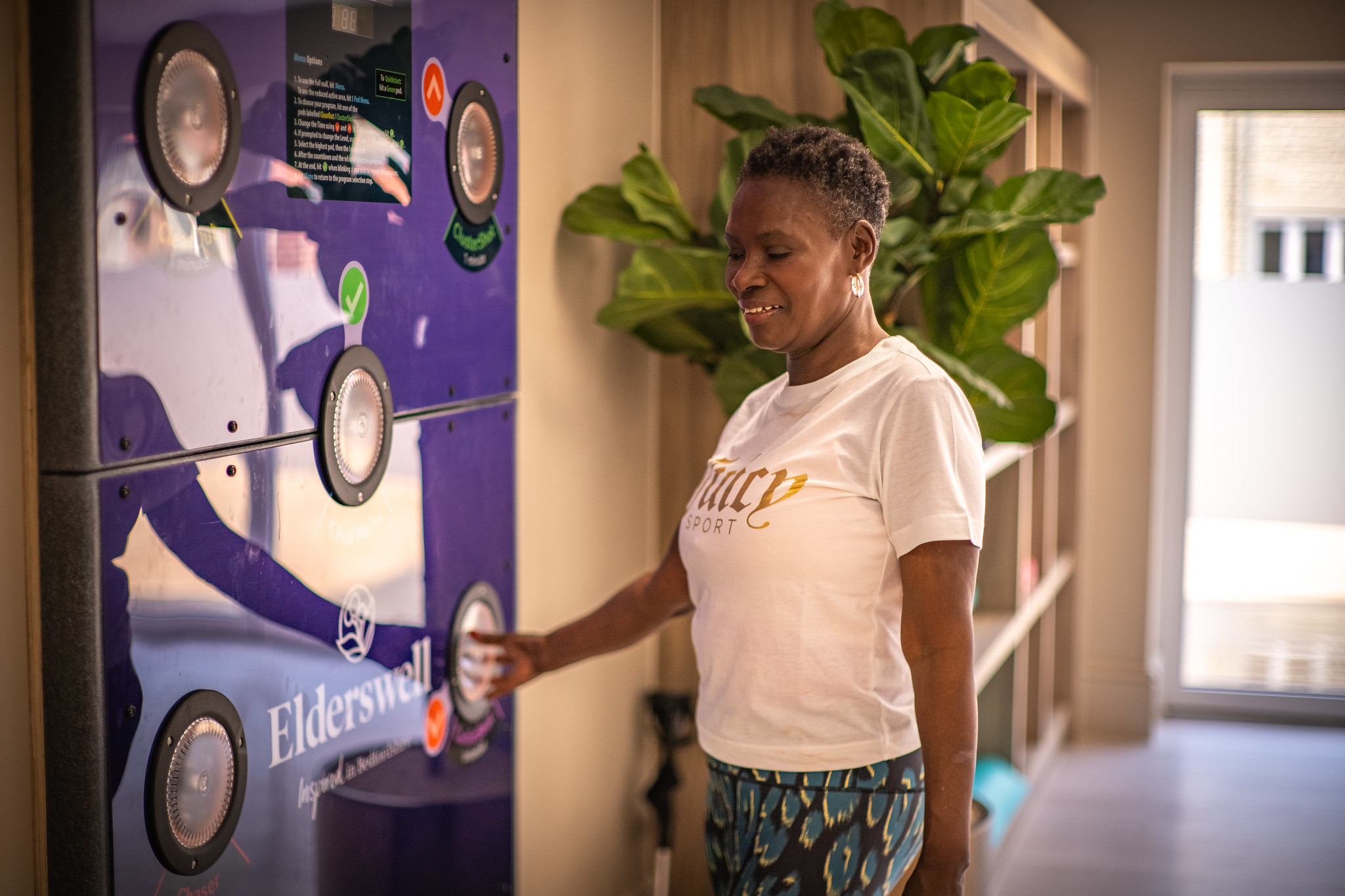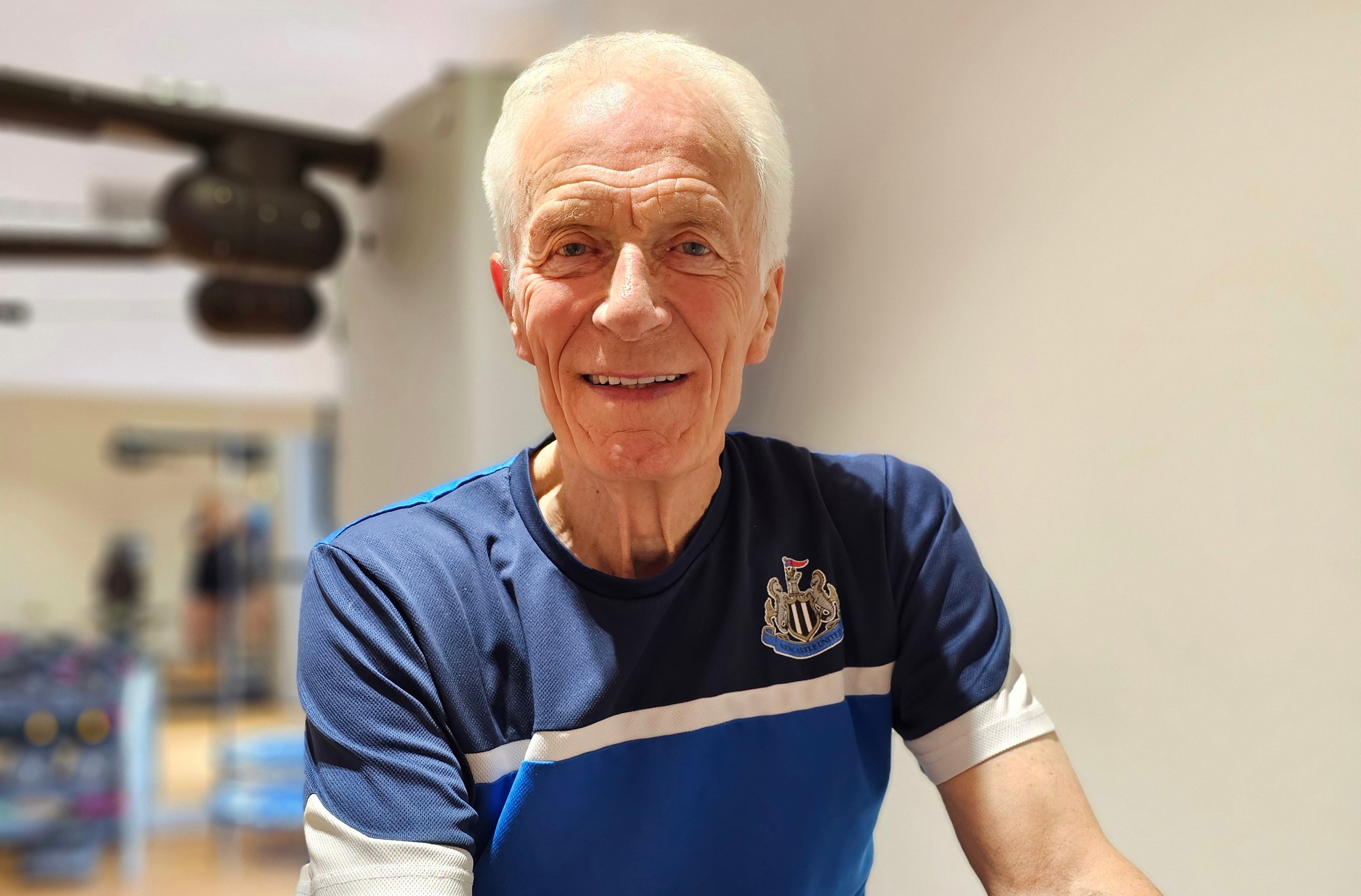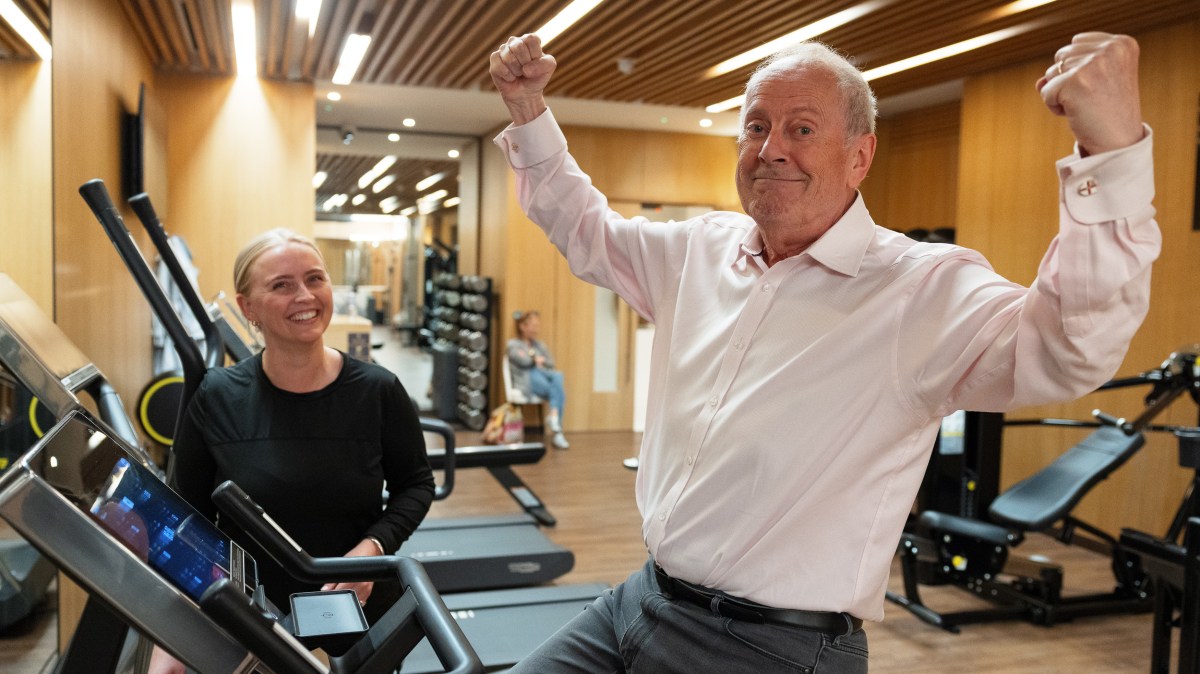The rigorous fitness regime Rod Stewart undergoes so he can prance around the stage at Glastonbury at the age of 80 is matched only by his fellow rocker Mick Jagger, who at 88 does running, kick-boxing, cycling and ballet so he can still party late into the night with his young wife.
For performers with less strenuous routines, it can take just five minutes of exercise a day to make a big difference, as Gyles Brandreth discovered after embarking on an innovative health and fitness programme.
The former MP and broadcaster, 77, faced a physical crisis after he fell over and broke his arm three years ago. “It was a real wake-up call,” he admits. “I realised I needed to do something.” Having focused more on nourishing his mind and spirit, he realised he had neglected his body.

Brandreth’s busy schedule only allows for five minutes of daily exercise
Gideon Remfry, who has been transforming the lives of homeowners at Auriens retirement community in Chelsea, southwest London, was tasked with building Brandreth’s strength.
The Celebrity Gogglebox star has avoided exercise since childhood. He and his wife Michele Brown don’t cook but live off ready meals and supermarket sandwiches, not an ideal diet for a fit and healthy lifestyle.
So he embarked on an eight-week wellness programme with Remfry and his team, which involved having blood tests to measure his visceral fat levels, stress levels and other markers that looked at muscle ageing, mental and physical resilience, and metabolic flexibility (the efficient use of dietary fats as energy).
• Why you should do strength training at 70: try these exercises
Remfry, one of the top 25 trainers in the world, according to Men’s Fitness magazine, is a founder of the Kyros Project — a collective of health experts, which includes former Olympic athletes, nutritionists and biomedics. His business partner, Aidan Goggins, co-founded the Sirtfood diet, which its credited with transforming the singer Adele’s physique. Brandreth was in good hands.
For Brandreth, it was vital for any exercise programme to fit into his busy schedule and not the other way round. He is a busy chap and does not have much spare time. In fact he is so busy he couldn’t even manage seven minutes a day. It had to be five.
“I have never been interested in exercise. When I was very little I ran for Hampshire in the 440 and 880 yards. But I didn’t like team sports — I exaggerated a stomach ache to get out of rugby at school to such an extent that I ended up having my appendix removed when it wasn’t necessary,” he adds.
“I realise that exercise needs to be central to my life,” he acknowledged, three years after falling and breaking his arm. “It was a real wake-up call because I brought my wife down with me. But I sought out the help of a professional because unlike my wife they accentuate the positive. She just tells me to stand up straight.”
Another wake-up call was when Brandreth was mistaken for Joe Biden on a visit to Ireland. “That was a dreadful humiliation,” he says.
Figures from the Nuffield Trust in 2016 reveal that more than two fifths of the NHS budget is spent on those over the age of 65. They also account for some 40 per cent of hospital admissions. And half of people aged over 80 suffer a fall each year.

Brandreth’s routine includes a one-minute plank
Brandreth needed to build muscle and strength. People fall over and break limbs in old age because they are weak. “I can only manage five minutes of stretching exercises a day,” he adds. “But Gideon suggested if I ‘perform’ them I will do them better.”
He adds: “There are deep breathing exercises, lunges, holding the plank for a minute, 15 push ups, standing on one leg for a minute. And I do resistance and weight training with my trainer who comes to my house once a week.”
He has not fallen since seeing Remfry. And his wife doesn’t tell him to stand up straight any more. He can jump up onto the stage and makes sure he combines some vegetables with his ready meals.
Retirement communities are pioneers when it comes to devising health and fitness regimes for older people. Remfry has been at Auriens for three and a half years. He has created and tweaked his programme over that time to help older people improve low muscle and low strength.

Brandreth has not fallen once since he began exercising
Even the gym equipment is user-friendly, with accessible treadmills, cross trainers and bikes. Although not a resident with Auriens, Brandreth is a brand ambassador.
All Auriens homeowners get a six-week training programme for free, which is valued at £1,200. It includes blood tests to measure anti-oxidant status, cellular stress and fat management as well as four massages and six personal training sessions. There are also group strength classes and aqua aerobics.
“Most of our owners are over 80, pre-diabetic and on cholesterol medication,” Remfry explains. “They also have sarcopenia — muscle loss and strength.”
His aim is to improve grip strength to lower the fall rate and improve recovery.
Brandreth’s tests results showed he was eating just 50 per cent of the protein he needed to build his muscle strength. And wasn’t doing enough exercise.
• Am I fit for my age? Exercises for your 30s to your 70s
“Some may think that five minutes isn’t very long but studies show that short bursts of high intensity exercise can be very effective,” Remfry adds.
After the eight weeks Brandreth had lost over a kilo in weight and improved his muscle strength.
The Geriatric Society reports that there will be double the number of over-85s by 2045. So they will need to keep fit to stay out of hospital.
Auriens conducted a survey measuring the mental and physical resilience of 20 of its residents aged 75 and over after they had done the fitness programme and lived at the village for a year. It found 64 per cent had increased skeletal muscle mass and 40 per cent had reduced blood cellular stress (indicating increased stress resilience).
At Riverstone, two retirement communities in Fulham and Kensington, a core fitness programme has been relaunched. “Stay Strong, Stay Standing” is designed to support strength, balance, and long-term independence. The package includes annual fitness reviews and classes including “Fall Proof”, an evidence-based falls prevention programme, as well as functional strength and aqua strength classes.
Riverstone is also offering dance classes as a fitness and brain booster. A Strictly-style Latin and ballroom course, launched in August, aligns with research showing that dancing can not only reduce the risk of developing dementia, but help older adults with mild cognitive impairment.

One of Inspired Villages’ cardio walls
Meanwhile, Inspired Villages employs wellbeing navigators at its 12 integrated retirement communities in Hampshire, Cheshire, Warwickshire and Kent. Two years ago it reported that after six months on its wellness programme residents could reduce their biological age by up to 8.8 years. It also found that a cardio wall and eGym equipment, which tracks strength workouts, boosted effectiveness when combined with exercise classes.
Other retirement operators, such as Rangeford, which has just launched its sixth village, Strawberry Fields, in Cambridgeshire, are employing GPs as health and wellbeing ambassadors. Dr Dawn Harper, from the TV series Old People’s Home for 4 Year Olds, is Rangeford’s wellbeing director. She is also is author of the book Live Well to 101. She travelled to the world’s “blue zones” — areas which have the highest concentration of healthy centenarians — to unearth the secrets of living a long and healthy life.
Retired businessman David Little, 81, believes it is important to have a passion for living to a healthy old age, and is the same weight he was when he married wife Gillian 58 years ago. He has run two marathons and always walks up the stairs to his first floor, two-bedroom apartment at Rangeford’s Wadswick Green retirement village in Wiltshire. He is also in the village’s gym at 8am three days a week — for an hour’s work out.

David Little in the gym at Wadswick Green in Wiltshire

Croquet at Wadswick Green
TOM CALTON
“I decided in my forties that what I wanted to achieve in life was to be fit and healthy in old age,” he says.
Being fit also meant he recovered quickly after he had a cardiac arrest eight and a half years ago. “Within three hours of collapsing I was discharged with three stents and never looked back.”
Living in a retirement community means he has a gym, swimming pool and table tennis table on his doorstep, plus land landscaped grounds for long walks. There’s also a village hall for Pilates and yoga glasses.
• Social media ruined conversation. But not at this retirement village
“I don’t like going to the gym,” he admits. “But I like the benefits.” And like Brandreth, he believes it is better to have a routine you can stick to. “Don’t make it too ambitious,” he advises, “Or you won’t keep it up.
“I use the machines, for running, cycling, rowing, and walking. I also use resistance weights but I’m not trying to prove anything,”
He still drives a sports car and likes living among a community of older people who embrace life. “We have one resident, aged 85, who went to Glastonbury.” So eat your heart out, Rod Stewart.
